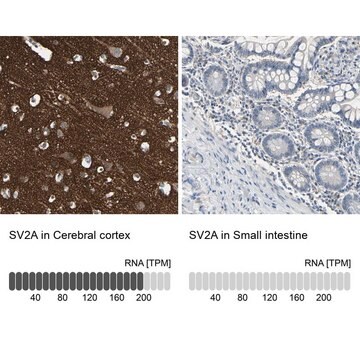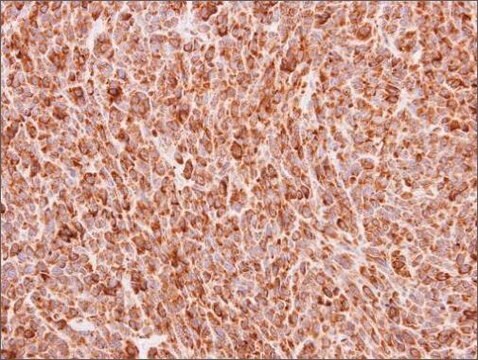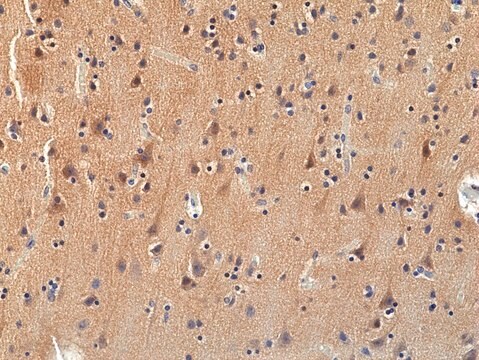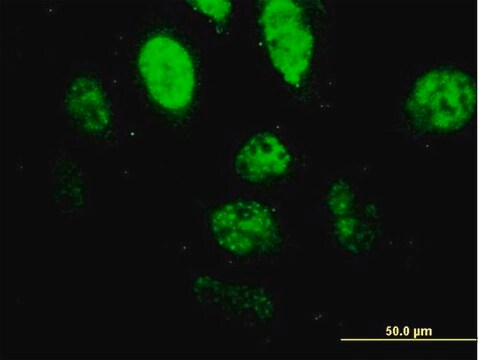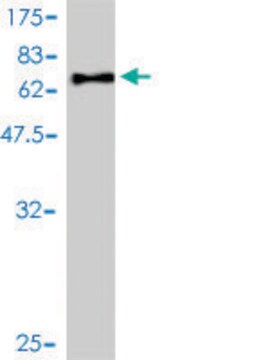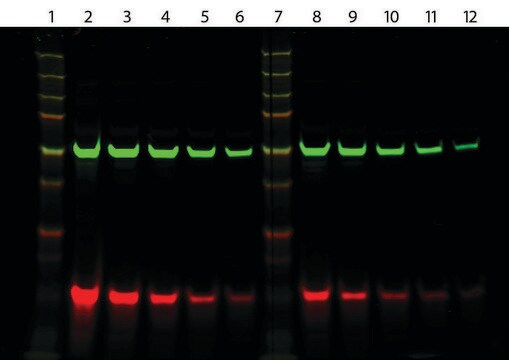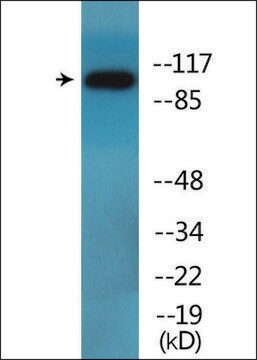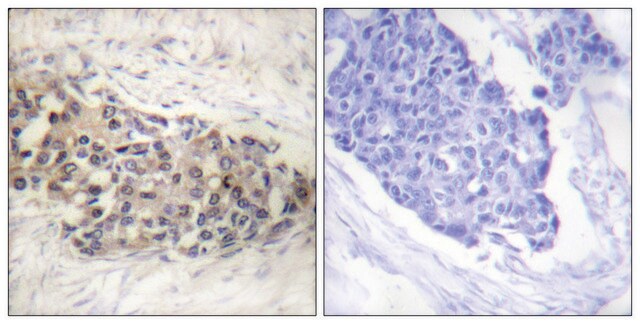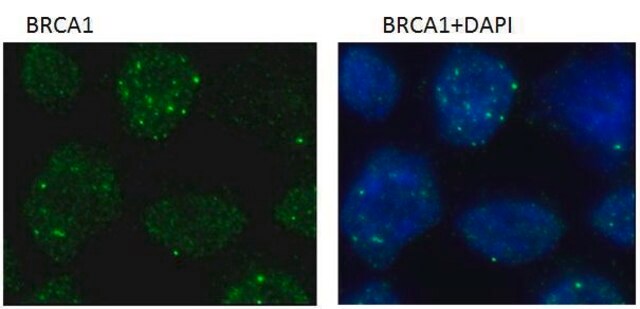General description
We are committed to bringing you greener alternative products, which adhere to one or more of The 12 Principles of Green Chemistry.This antibody is Preservative-free, produced without the harm or sacrifice of animals and exceptionally stable to allow for ambient shipping and storage if needed and thus aligns with "Waste Prevention", "Designing Safer Chemicals" and "Design for Energy Efficiency".
Click here for more information.
ZooMAb® antibodies represent an entirely new generation of recombinant monoclonal antibodies.Each ZooMAb® antibody is manufactured using our proprietary recombinant expression system, purified to homogeneity, and precisely dispensed to produce robust and highly reproducible lot-to-lot consistency. Only top-performing clones are released for use by researchers. Each antibody is validated for high specificity and affinity across multiple applications, including its most commonly used application. ZooMAb® antibodies are reliably available and ready to ship when you need them.
Specificity
Clone 3E18 is a ZooMAb® Rabbit recombinant monoclonal antibody that specifically detects TrKB. It targets an epitope within 18 amino acids from the extracellular domain within the N-terminal half.
Immunogen
KLH-conjugated linear peptide corresponding to 18 amino acids from the extracellular domain within the N-terminal half.
Application
Quality Control Testing
Evaluated by Immunocytochemistry in Neuro 2A cells.
Immunocytochemistry Analysis: A 1:100 dilution of this antibody detected TrkB in Neuro 2A cells.
Tested applications
Affinity Binding Assay: A representative lot of this antibody bound TrkB peptide a KD of 1.6 x 10-6 in an affinity binding assay.
Enzyme Immunoassay Analysis (ELISA): Serial of dilutions of this antibody detected recombinant human TrkB.
Note: Actual optimal working dilutions must be determined by end user as specimens, and experimental conditions may vary with the end user
Evaluated by Immunocytochemistry in Neuro 2A cells.
Immunocytochemistry Analysis: A 1:100 dilution of this antibody detected TrkB in Neuro 2A cells.
Target description
BDNF/NT-3 growth factors receptor (UniProt: Q16620; also known as EC:2.7.10.1, GP145-TrkB, Trk-B, Neurotrophic tyrosine kinase receptor type 2, TrkB tyrosine kinase, Tropomyosin-related kinase B) is encoded by the NTRK2 (also known as TRKB) gene (Gene ID: 4915) in human. TrkB is a single-pass type I membrane glycoprotein that is internalized to endosomes upon ligand-binding. It is synthesized with a signal peptide (aa 1-31) that is subsequently cleaved off to produce the mature form that contains an extracellular domain (aa 32-430), a transmembrane domain (aa 431-454), and a cytoplasmic domain (aa 455-822). TrkB is a receptor tyrosine kinase that is involved in the development and maturation of the central and the peripheral nervous systems through regulation of neuron survival, proliferation, migration, differentiation, and synapse formation and plasticity. In the central nervous system, its expression is observed in the cerebral cortex, hippocampus, thalamus, choroid plexus, granular layer of the cerebellum, brain stem, and spinal cord. In the peripheral nervous system, it is expressed in many cranial ganglia, the ophthalmic nerve, the vestibula, and multiple facial structures. Its expression is highly regulated and determines the sensitivity of neurons to BDNF. Upon ligand-binding, TrkB undergoes homodimerization, autophosphorylation, and activation. It can then recruit, phosphorylate and/or activate several downstream effectors including SHC1, FRS2, SH2B1, SH2B2 and PLCG1 that regulate distinct overlapping signaling cascades. TrkB is also reported to play a role in neutrophin-dependent calcium signaling in glial cells and mediate communication between neurons and glia. Following binding of BDNF to TrkB receptor, Tyrosine 816 is phosphorylated, which allows the binding of phospholipase C and activation of signaling cascade. This ZooMAbZooMAb® recombinant monoclonal antibody, generated by our propriety technology, offers significantly enhanced specificity, affinity, reproducibility, and stability over conventional monoclonals. (Ref.: Andreska, T., et al. (2020). Cell Tissue Res. 382(1); 5-14; Klein, R., et al. (1991). Cell. 66(2); 395-403).
Physical form
Purified recombinant rabbit monoclonal antibody IgG, lyophilized in PBS, 5% Trehalose, normal appearance a coarse or translucent resin. The PBS/trehalose components in the ZooMAb formulation can have the appearance of a semi-solid (bead like gel) after lyophilization. This is a normal phenomenon. Please follow the recommended reconstitution procedure in the data sheet to dissolve the semi-solid, bead-like, gel-appearing material. The resulting antibody solution is completely stable and functional as proven by full functional testing. Contains no biocide or preservatives, such as azide, or any animal by-products. Larger pack sizes provided as multiples of 25 μL.
Reconstitution
300 μg/mL after reconstitution at 25 μL per vial. Please refer to guidance on suggested starting dilutions and/or titers per application and sample type.
Storage and Stability
Recommend storage of lyophilized product at 2-8°C; Before reconstitution, micro-centrifuge vials briefly to spin down material to bottom of the vial; Reconstitute each vial by adding 25 μL of filtered lab grade water or PBS; Reconstituted antibodies can be stored at 2-8°C, or -20°C for long term storage. Avoid repeated freeze-thaws.
Legal Information
ZooMAb is a registered trademark of Merck KGaA, Darmstadt, Germany
Disclaimer
Unless otherwise stated in our catalog or other company documentation accompanying the product(s), our products are intended for research use only and are not to be used for any other purpose, which includes but is not limited to, unauthorized commercial uses, in vitro diagnostic uses, ex vivo or in vivo therapeutic uses or any type of consumption or application to humans or animals.


